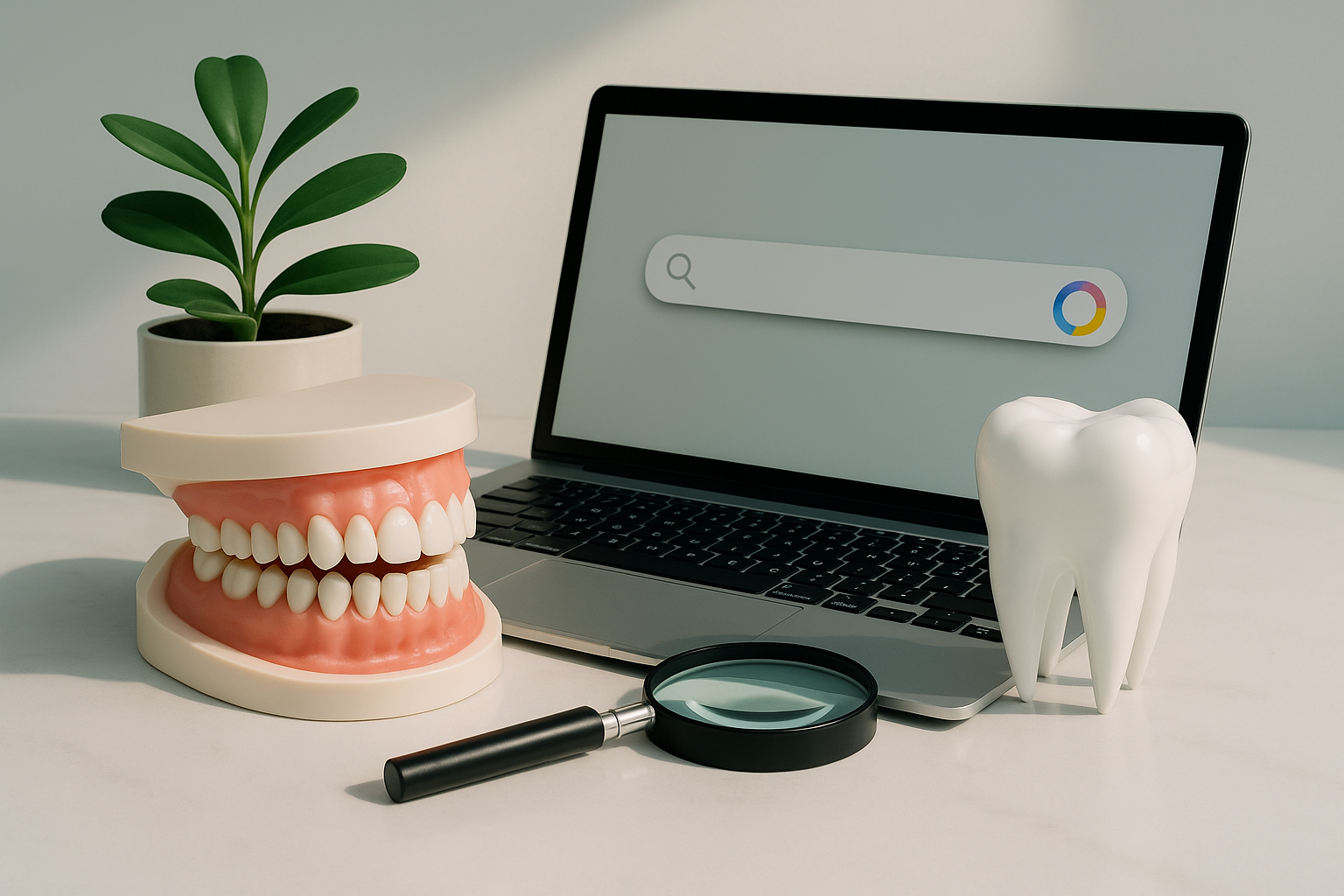High-Converting Dental Websites: What Actually Works in 2025
I recently analyzed a website that cost a dental practice owner $30,000 to build.
It was beautifully designed, had stunning photography, and looked incredibly professional. But when I searched for the appointment request button, I couldn't find it anywhere on the homepage.
This expensive, gorgeous website was doing absolutely nothing to convert visitors into patients. Meanwhile, one of our Digital Floss clients saw 900 website visits in 30 days, generated 42 click-to-calls, and received 22 lead submissions from new patients — without any Google Ad spend — all because her website was built for conversion, not just aesthetics.
After two decades of helping dental practices grow, I've learned that the websites that actually fill chairs look very different from the websites that win design awards. And in 2025, with AI systems evaluating your website for recommendations and patients expecting immediate answers to their questions, conversion-focused design is essential.
Why Do Most Dental Websites Fail to Convert Visitors?
Most dental websites are built like brochures from 2009. They open with a stock photo or drone footage of a building, maybe some generic text about providing excellent care, and somewhere buried in the navigation, you might find a way to schedule an appointment.
These websites are designed to look impressive, not to convert visitors into patients.
When potential patients land on your website, they’re looking for answers to their questions and a sign that they can trust you to help them. They also want an effortless way to book an appointment. People choose dentists based on trust, connection, and confidence that you understand their needs.
What Should Appear Above the Fold on Dental Websites?
The area above the fold — what visitors see before scrolling — determines whether someone becomes a patient or clicks back to Google. Most dental websites waste this critical space with stock photos or generic messaging that could apply to any practice.
The websites that convert consistently follow what I call the Hook, Story, Offer framework. The hook is what brought them to your website — maybe they searched for "dental implants" or found you through Instagram. The story is deeply personal video content that builds emotional connection and demonstrates your expertise. The offer is the clear, prominent way for them to take the next step.
The first thing people should see on your website is a video where you introduce yourself, explain your approach to patient care, and address common concerns patients have about dental treatment. To the right of this video, include a clear appointment request form with prominent call-to-action buttons.
The brain processes information from left to right — visitors watch the video that creates emotional connection, then immediately see how to schedule their appointment. This simple layout change can dramatically improve conversion rates without any other modifications.
How Do Patients Actually Make Decisions About Dental Care?
Understanding patient psychology is crucial for website conversion. When people visit dental websites, they're often anxious about treatment, concerned about cost, and uncertain about which practice to choose. Your website needs to address these concerns directly and immediately.
The most effective approach moves patients from head-based decisions to heart-based decisions. Head-based decisions focus on cost and convenience — "let me find the cheapest option." Heart-based decisions are driven by trust and emotional connection — "I feel confident this doctor understands my situation."
Video content creates this emotional shift better than any other element. When patients see you explaining procedures, addressing their concerns, and sharing your philosophy about patient care, they begin to feel like they know you before they even call your office.
I've seen this transformation repeatedly with Digital Floss clients. Practices that add authentic video content above the fold consistently report that new patients arrive more informed, more committed, and more likely to accept treatment recommendations.
What Technical Elements Actually Impact Conversion?
While emotional connection drives decision-making, technical elements determine whether visitors can easily take action. The most important technical consideration is mobile optimization — most dental website visitors are using smartphones, and if your site doesn't work perfectly on mobile, you're losing potential patients immediately.
Page loading speed critically impacts conversion rates. If your website takes more than three seconds to load, visitors will return to Google and find a competitor. Video content can slow loading times if uploaded directly to your website, but embedding from YouTube maintains fast loading while providing the conversion benefits of video.
Clear navigation that uses familiar terms helps visitors find what they need quickly. Instead of creative menu labels like "Our Spectacular Suite of Services," use straightforward terms like "Services" or "Treatments." Don't make visitors guess where to find information about procedures or how to schedule appointments.
Contact information should be visible on every page, preferably in the header. Include your phone number prominently with click-to-call functionality for mobile users. Make it as easy as possible for interested visitors to contact your practice immediately.
How Do AI Systems Evaluate Dental Websites for Recommendations?
AI systems like ChatGPT and Google's SGE evaluate websites differently than traditional search engines. They look for content that directly answers patient questions, demonstrates authentic expertise, and provides clear information about services and location.
Websites that get recommended by AI systems typically include comprehensive FAQ sections that address common patient concerns. Instead of generic content about "providing excellent care," these sites answer specific questions like "What happens during dental implant surgery?" or "How do I prepare for my first visit?"
AI systems also value websites that demonstrate authentic expertise through educational content. Practices that regularly publish blog posts, procedure explanations, and patient education materials signal to AI that they're active, knowledgeable providers rather than static websites.
Structured data markup helps AI systems understand your services, location, and expertise. This technical element isn't visible to visitors but provides context that AI systems use when making recommendations.
What Conversion Elements Do High-Performing Dental Websites Share?
After analyzing hundreds of dental websites and their conversion performance, certain elements consistently appear on the highest-converting sites. These websites feature authentic video content prominently displayed, clear and multiple call-to-action buttons throughout the site, and comprehensive service information that answers patient questions before they need to call.
The highest-converting websites also include real patient testimonials with specific details about treatment experiences. Generic testimonials like "Great service!" don't build trust, but detailed testimonials that describe the patient's experience and outcome do create confidence in potential patients.
Online appointment scheduling capabilities significantly improve conversion rates, especially for younger patients who prefer booking online to making phone calls. However, always include phone contact options for patients who prefer speaking with a real person.
Social proof elements like online reviews, awards, and professional credentials build credibility, but they should support rather than replace the primary conversion elements of video content and clear calls-to-action.
How Should Dental Websites Address Common Patient Concerns?
Most dental website visitors have specific concerns that prevent them from scheduling appointments: fear of pain, anxiety about procedures, uncertainty about cost, and questions about what to expect. Your website should address these concerns proactively rather than waiting for patients to call with questions.
Include detailed information about your approach to pain management and patient comfort. Many patients choose dental practices based on how well they handle dental anxiety, so this information can be a significant competitive advantage.
Provide clear information about accepted insurance plans and payment options. Cost uncertainty prevents many patients from scheduling appointments, so transparency about financial options can improve conversion rates significantly.
Explain what patients can expect during their first visit and common procedures. The unknown creates anxiety, but patients who understand the process are more likely to move forward with treatment.
Address scheduling and location logistics clearly. Include your address with directions, parking information, and office hours prominently on your website.
How Can Existing Websites Be Improved Without Complete Redesigns?
Most dental websites can significantly improve conversion rates with strategic modifications rather than complete rebuilds. Adding video content above the fold often provides the biggest conversion improvement for the least investment.
Optimize your call-to-action buttons by making them larger, more prominently placed, and using action-oriented language like "Schedule Your Visit" instead of generic terms like "Contact Us."
Improve your mobile experience by testing your website on smartphones and ensuring all functionality works perfectly. Many conversion problems come from mobile optimization issues that are relatively simple to fix.
Add comprehensive FAQ sections that address common patient concerns. This content improves both conversion rates and AI search visibility.
Update your contact information presentation to make phone numbers and addresses more prominent throughout the site.
The practices seeing the best results from website optimization focus on conversion improvements rather than aesthetic changes. A website that converts visitors into patients is infinitely more valuable than one that merely looks impressive.
About Dr. Anissa Broussard
Dr. Anissa Broussard is a dentist with over 20 years of clinical experience and dentistry's leading digital marketing expert. She is the co-founder of Digital Floss, a full-service dental marketing agency specializing in AI-optimized strategies for dental practices, and DentalFlix, the premier online education platform for dental practice training. Named one of the Top 25 Women in Dentistry, she was the first in the dental industry to discover how sales funnels can work in dental practices.
Dr. Broussard was recruited by ClickFunnels to create the Brick and Mortar Funnel Framework and holds a Fellowship with the Dental Speaking Institute. She has keynoted at major events including the AACD, Social Media Marketing World, and Funnel Hacking Live.












